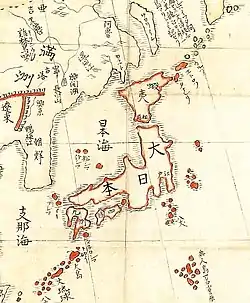Shōō (Kamakura period)
Shōō (正応) was a Japanese era name (年号,, nengō,, lit. "year name") after Kōan and before Einin. This period spanned the years from April 1288 through August 1293.[1] The reigning emperor was Fushimi-tennō (伏見天皇).[2]
| History of Japan |
|---|
 |
Change of era
- 1288 Shōō gannen (正応元年): The new era name was created to mark an event or a number of events. The previous era ended and a new one commenced in Kōan 11.
Events of the Shōō era
- April 16, 1288 (Shōō 1, 15th day of the 3rd month): The accession of Emperor Fushimi took place.[3]
- 1288 (Shōō 1): Oracles of the three deities — Amaterasu, Hachiman and Kasuga appeared on the surface of the pond at Todaiji in Nara.[4]
- May 26, 1293 (Shōō 6, 13th day of the 4th month): An earthquake in Kamakura, Japan kills an estimated 23,000.[5]
Notes
- Nussbaum, Louis-Frédéric. (2005). "Shōō" in Japan Encyclopedia, p. 885, p. 885, at Google Books; n.b., Louis-Frédéric is pseudonym of Louis-Frédéric Nussbaum, see Deutsche Nationalbibliothek Authority File Archived 2012-05-24 at Archive.today.
- Titsingh, Isaac. (1834). Annales des empereurs du japon, p. 269-274; Varley, H. Paul. (1980). Jinnō Shōtōki. pp. 237-238.
- Perkins, George W. (1998). The Clear Mirror: a Chronicle of the Japanese Court during the Kamakura Period (1185-1333), p. 137., p. 137, at Google Books
- Breen, John and Mark Teeuwen. (2000). Shinto in History: Ways of the Kami, p. 174., p. 174, at Google Books
- Hattori, J. (4 April 1878). "Destructive Earthquakes of Japan". The Japan Mail: A fortnightly summary of intelligence from Japan, for transmission to Europe and the United States, via Suez and San Francisco. p. 178. Retrieved 24 February 2019.
References
- Nussbaum, Louis-Frédéric and Käthe Roth. (2005). Japan encyclopedia. Cambridge: Harvard University Press. ISBN 978-0-674-01753-5; OCLC 58053128
- Titsingh, Isaac. (1834). Nihon Odai Ichiran; ou, Annales des empereurs du Japon. Paris: Royal Asiatic Society, Oriental Translation Fund of Great Britain and Ireland. OCLC 5850691
- Varley, H. Paul. (1980). A Chronicle of Gods and Sovereigns: Jinnō Shōtōki of Kitabatake Chikafusa. New York: Columbia University Press. ISBN 978-0-231-04940-5; OCLC 6042764
External links
- National Diet Library, "The Japanese Calendar" -- historical overview plus illustrative images from library's collection
| Preceded by Kōan |
Era or nengō Shōō 1288–1293 |
Succeeded by Einin |
This article is issued from Wikipedia. The text is licensed under Creative Commons - Attribution - Sharealike. Additional terms may apply for the media files.